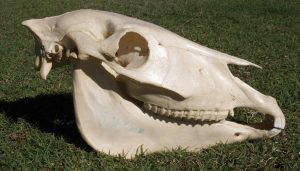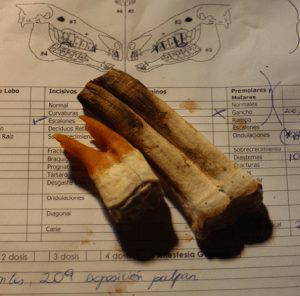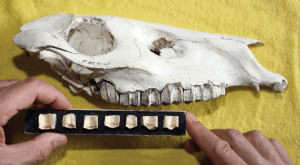WORDS BY Dr Shannon Lee
BVSc, MANZCVSc Eq Dent, DICEVO
Selective breeding
Part of the reason for this also relates to the (selective) breeding of horses. If we discount the last 54,900,900,000, then in just this last short period, humans have had a huge impact on the size, shape and appearance of horses. In contrast, there has been little to no thought on the effects selection has on their dental evolution and health.
Horses are bred for size, shape, speed, temperament, gait and colour amongst other things. However, when did you ever hear of someone checking a stallion’s teeth before breeding a mare to them? Or considering the effects the different head sizes and shapes might have when cross bred?
If you’ve followed the article this far, let’s now take a look at some of the different ancestors of the modern horse. You are going to hear the term Hippus a lot because it is used in the name of each ancestral species, so apologies in advance if it might seem a little confusing.
Eohippus
Beginning around 55 million years ago, we have Eohippus.
This is the dog-sized early ancestor of the horse which had seven cheek teeth in each dental arcade – four premolars and three molars. Anatomically, the premolar and molar are identical. The distinction is whether the tooth has both an adult and a baby variety. If so, it’s classed as a premolar. Molars, on the other hand, erupt a little later in life and do so only as an adult tooth.
Eohippus’ whole skull would fit in your hand and the cheek teeth were covered in enamel. Teeth are made up of three mineralised tissues – enamel, cementum and dentine – with enamel being the hardest of these.
So, the teeth of Eohippus where covered in enamel, which was one of the things to change in later species as they adapted and shifted from brachyodont dentition to hypsodont. The cheek teeth had low crowns and the molars where described as being uneven, dull and bumpy with the high points (cusps) being slightly connected, tooth to tooth, by low crests.
Interestingly, the basic tooth layout only differed in the aforementioned number of premolars. Just like a modern horse, Eohippus had three incisor teeth in each arcade and one canine tooth.
Orohippus
The next in the evolutionary tree was Orohippus around 50 million years ago.
It was around the same size as Eohippus, but more slender and probably a better jumper. The teeth of Orohippus showed some significant changes.
Here, 50 million years ago, we see the first premolar getting much smaller (the start of changes that lead to the wolf tooth), the last premolar shifted into a molar (no deciduous tooth) and the chewing surfaces of the tooth became more pronounced. All of these changes point to Orohippus being better able to eat tougher plant material than Eohippus.
Epihippus
Next, we have Epihippus around 47 million years ago.
Still only a few feet tall or about 60cm, Epihippus continued the trend of dental changes associated with improved grinding ability. Interestingly, it had only five cheek teeth!
Mesohippus
Estimates vary, but we are now looking at an animal from around 30-40 million years ago. Mesohippus literally means ‘middle horse’ and it is here that we see a horse with six cheek teeth (molars and premolars) and a small seventh tooth (again the evolution of the wolf tooth). Further changes or improvements to the grinding surfaces are also seen and the horse is slightly larger, with a longer, more slender skull and a larger space for its brain.
At this time, we reach an interesting example of how the evolution of the horse is complex and more like the branches of a tree than the stops on a train line.
Miohippus
Miohippus, literally meaning ‘the lesser horse’, evolved some 36 million years ago. They developed cladogenetically, rather than anagenetically.
This means, whilst they are related to the Mesohippus, they didn’t develop through a series of evolutionary changes and then become the direct descendants of Mesohippus. Instead, they most likely developed from an isolated group of Mesohippus who evolved and then both species existed at the same time. In fact, the two species co-existed (whilst each still undergoing evolution) for around 4 million years.
It was towards the end of this period (the Oligocene period around 25 million years ago) that we see the extinction of Mesohippus. However, Miohippus continued to thrive and to diversify existing for another 20 million years or so (the Miocene period).
It was during this time that great changes were taking place in the environment, with less forested areas and the development of large grass lands.
During this period, we see lengthening of the jaw, deepening of the tooth sockets, increased molarisation of the premolar teeth and a shift to hypsodont dentition.
The splitting of Miohippus into two groups lead to Kalobatippus and Parahippus.
Parahippus was a grazer on the grass plains, whereas Kalobatippus was the group still dwelling in forested areas. The front teeth, or incisors, of Parahippus show the first signs of the development of an infolding (an area later called the infundibulum, which is a significant point in the dental evolution of the horse). Parahippus again continued the trend of increased size, physical adaptions associated with grazing and avoiding predation, and was about the size of a small pony.
Merychippus
Next comes Merychippus, which evolved in the middle of the Miocene period around 20 million years ago. This is considered a milestone in the evolution of the modern horse.
Estimates in size vary from around 1m to up to as high as 1.8m. Certainly, Merychippus was the largest species of equid at the time and it had a number of adaptations related to grazing.
Its eyes were wider apart. They were also set further back and this was partly to accomodate longer tooth roots. The space for its brain was larger, it had longer more slender limbs, and was the first ancestor of the modern horse to show the modern skull shape and a longer neck.
Dentally, a significant change also took place. Up until now, the outside of the teeth was coated with enamel (the hard outer layer) but, for the first time, we see an adaptation to have a further layer of cementum outside of this.
Showing that evolution is not always linear, after Merychippus three distinct species evolved – Hipparion, Pliohippus and Protohippus.
Until recently, it was thought Pliohippus was the ancestor of the modern horse because of its many anatomical similarities. However, we appear to have a gap in the chain of evolution because, during this period, many species of horse existed and, whilst the Dinohippus is seen as the direct ancestor of the later developed Equus, via a species called Plesihippus (the first to finally resemble the modern horse in size at around 450kg), no one is quite sure which species Dinohippus directly evolved from.
Equus
Finally we reach Equus around 5 million years ago. Somewhere around 2.5 million years ago, it’s thought some of the Equus species migrated to Asia, Europe and Africa via a land bridge that connected the continents with North America and, it is from this group the modern equids (horse, zebra and ass) are derived. The species that remained in North and South America became extinct and, today, fossils documenting the equine evolution have been found around the world, except in Antarctica and here in Australia.
Phew that’s quite an exhausting line of hippus’ and we only looked at the key ones so, hopefully, it made sense!
 IMAGE A: Modern horse skull. Image courtesy MB Equine Services.
IMAGE A: Modern horse skull. Image courtesy MB Equine Services.
 IMAGE B: This image shows the difference in length, but also the changes as the horse ages. Notice the large young tooth has no roots, whereas the shorter older tooth has significant root development. Image courtesy Advanced Equine Dentistry.
IMAGE B: This image shows the difference in length, but also the changes as the horse ages. Notice the large young tooth has no roots, whereas the shorter older tooth has significant root development. Image courtesy Advanced Equine Dentistry.
 IMAGE C: Due to the large fossil record that exists, researchers have been able to rank the shaprness of the cusps of the molars of fossil horses to better understand how horses’ teeth evolved over time due to diet and climate change. Photo courtesy Matthew Mihlbachler.
IMAGE C: Due to the large fossil record that exists, researchers have been able to rank the shaprness of the cusps of the molars of fossil horses to better understand how horses’ teeth evolved over time due to diet and climate change. Photo courtesy Matthew Mihlbachler.
Search
Recent Articles
- How to take a horse from SHOES to BAREFOOT with Alex Ridgeway & Dr Mark Caldwell
- 8 Laminitis Myths Busted!
- I’ve learnt as I’ve got older to really listen to what the people around me say about others
- The dangers of sleep deprivation in horses
- The third part of our series on stretching and flexibility with Sharon Stuart or Stuart Equine – forelimb and neck stretches for the horse and shoulder stretches for the rider
Categories
- Advice Hub
- Athlete
- Carriage Driving
- Dentistry
- Dressage
- Endurance
- Eventing
- Farrier
- Featured
- Featured Horse Ads
- Featured Posts
- Horse Racing
- Horse's Mouth
- Horseball
- Hunting
- Le Trec
- Leisure Riders
- Mounted Games
- Nutrition
- Polo
- Polocrosse
- Reining
- Rescue & Rehabilitation
- Show Jumping
- Showing
- Tack Room
- Team Chasing
- The Pony Club
- Therapy
- Training
- Vaulting
- Veterinary




